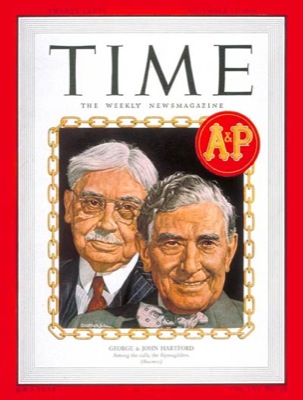A retailer develops a new format for distributing and selling products that turns out to be wildly successful. Spreading like a juggernaut across the country, the company goes from being an insignificant regional chain to the world’s largest retailer in little more than a decade, leading frantic competitors to seek protection through government regulation.
Walmart in the 1990s? Could be, but I am specifically referring to the Great Atlantic & Pacific Tea Company (A&P) in the 1910s and 1920s. Founded by George Huntington Hartford, he left the company in trust to his five children when he died in 1918. Two of those children, George Ludlum and John Augustine Hartford, led the company through its growth years.

November 13, 1950 cover of Time. Note the gold chain around the photo representing A&P’s position as the largest chain store in the world. (Click for a larger image.)
George was the financial manager; John was the innovator who developed the “economy store” (a tiny cash-and-carry store run by only one clerk) in 1912, which multiplied into nearly 16,000 stores by 1930. When supermarkets became popular in the 1930s, John designed A&P’s first supermarket and over the next fifteen years built nearly 5,000 more, closing several economy stores for each supermarket opening.







